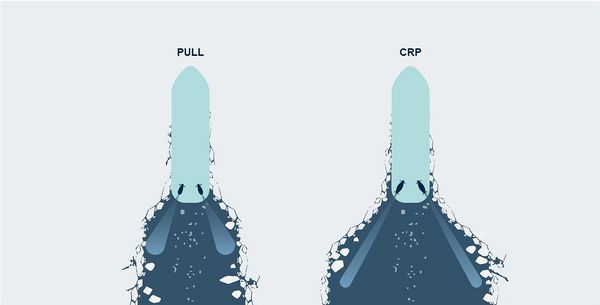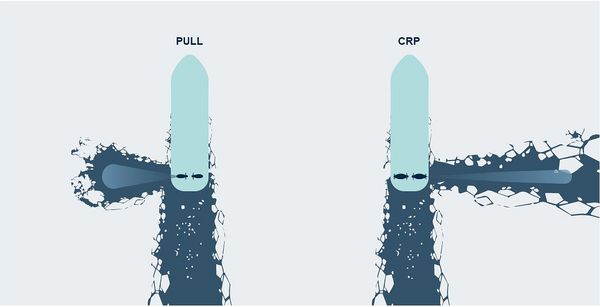If you operate icebreakers, high-ice-class cargo ships, LNG-carriers or offshore vessels designed for independent operation, you will want to handle your vessels safely through the harshest ice conditions and Polar Code areas. Today’s modern icebreakers and icebreaking cargo vessels are typically equipped with azimuth propulsors, which is a very effective proven technology. Steerprop’s unique azimuth solutions take reliability and efficiency to an entirely new level with a fuel economy that saves costs and reduces emissions.
In recent years, new Arctic shipping routes, such as the Northwest Passage and other Arctic areas, have become viable for merchant shipping. These new routes are causing an increasing demand for icebreaking and ice management vessels. In addition to supporting commercial shipping, icebreakers provide important links to remote areas in the northern regions through the resupply of goods. Another critical task for icebreakers is to enable supply chains, via ships calling at ports in Polar Code areas as well as in regions with cold winters when ice is a threat to both vessels and harbors, for example, in the Great Lakes – the St. Lawrence Trade Corridor in Canada and the United States.
Ice management is the key
The key to keeping fairways and harbors clear is ice management. Operating in ice conditions is either done independently with an ice-classed vessel or through assistance from an icebreaker. At Steerprop, ice management is a way to handle ice-covered seas and waterways using azimuth thrusters, in other words, breaking ice, clearing ice ridges, opening shipping routes, breaking up ice around structures (e.g., oil rigs or wind farm construction sites) and ensuring that ports remain unrestricted by ice.
Solutions are already available that can turn an icebreaker, for example, into a multipurpose ice management vessel. Today, azimuth propulsors are the industry standard for icebreaking vessels. Azimuth propulsors are efficient, and especially their ability to direct the vectored slipstream from the propeller in a full 360 degrees is a game changer. This allows a vessel to use the thrust itself not only to open and widen fairways but also to clear ice ridges and free merchant vessels stuck in ice, as well as protect offshore installations or other physical assets from ice pressure.
CRP vs. single propeller propulsors
The propulsion system in modern icebreakers is typically based on azimuth propulsion technology, which has proven to be very effective for icebreakers and icebreaking cargo vessels. Since any lack of propulsion power can easily cause a ship to become stuck, the propulsion systems used must be reliable, flexible, redundant, maintainable as well as possess high power-to-weight and power-to-space ratios.
Steerprop is constantly developing propulsion technology that improves overall efficiency. Contra-rotating propulsion (CRP) technology meets the most challenging customer needs. Steerprop’s dual-end contra-rotating propellers (CRP) in a push-pull configuration allows for high maneuverability, higher bollard pull/DP-thrust compared to single open propellers, outstanding ice management capabilities and low emissions due to good fuel economy. The power range is from 900 kW to15,000 kW.
Azimuth CRP propulsors – the ideal choice for icebreakers
Ships operating in ice and Arctic conditions often rely on the width of the channel opened by the icebreaker. Since cargo today is transported using increasingly larger and thus wider merchant ships, the larger beams mean that icebreakers must open channels wider than the width of the icebreaker itself. This problem can be solved using azimuth propulsors.
Azimuth propulsors can always be directed in the desired direction to clear ice. Therefore, they can provide a wider channel than the icebreaker’s width. But as Figure 1 illustrates, Steerprop’s CRP can make an even wider channel. With its sophisticated hydrodynamic design of the underwater parts, the CRP creates a narrower and more powerful slipstream behind the propulsor (wake side) than a single propeller in pull configuration; hence, the stream from the CRP reaches further using the same propulsor power.
In other words, if the stream is directed toward the ice, the ice formation will break up at various distances depending on the power and thickness of the ice field. (See Figure 2) However, since the CRP stream is more concentrated than a single-pull propeller, the effect extends further. The benefits for icebreakers are that they are able to open wider channels or have an extended impact on ice management by exercising prop wash (clearing ice).
Remarkable 50% increase of speed in brash ice
Steerprop conducted a series of ice model tests at Aker Arctic Technology’s ice laboratory in Finland to gain more data to verify the benefits of CRP propulsors. The ice basin tests compared CRPs against traditional single-propeller azimuth propulsors currently used in ice-going applications.
The results show that in bollard configurations, CRP provides a higher thrust of approximately 10% using the same power, or the same thrust using 15% lower power when compared to a single propeller of the same diameter. The CRP can benefit several applications – from dedicated icebreakers and Arctic cargo ships to tankers and ice-going offshore support vessels. The net thrust of the CRP was 10-17% higher than a single-pull propeller with the same power.
Tests showed that the speed in brash ice could be increased by an impressive 50%
In addition to icebreakers, cargo ships designed to operate independently in polar ice conditions could typically benefit from Steerprop’s CRP solution. The tests showed that ice resistance can be reduced by approximately 10% in level ice, and the speed in brash ice was increased by an impressive 50%. The ridge penetration time was reduced by around 50%.
Previously, icebreaker operators often had to compromise regarding bollard pull/icebreaking thrust and free-running efficiency when choosing between an ice-class propeller (with an inferior propulsive performance) or a non-ice-class propeller. An ice-class propeller requires high propeller loading enabled by large blade areas and high hub ratios, whereas ducted propeller configurations, usually required for high bollard pull, present challenges with ice-clogging. Steerprop’s solutions are clog-free and provide superior performance in Arctic conditions, thus eliminating compromises and challenges.
Condition monitoring ensures reliability
There are evident risks with shipping in ice and Polar Code areas. Operating in such inaccessible and vast regions is always difficult and dangerous. Therefore, the harsh conditions and remoteness of these areas create a demand for high reliability to meet risk management standards.
Shipowners can achieve the highest possible reliability through enhanced predictability using additional tools, such as condition monitoring and predictable maintenance. Condition monitoring of the propulsion equipment allows crew members to follow machinery trends and detect deviations that could affect the propulsion system in the future.
Condition monitoring is available at different levels, from basic trend follow-up and deviation detection to clear value-adding in-depth professional analysis by Steerprop’s experts. In practice, this means that condition monitoring can cover the entire propulsion system, including vibration, along with signals and alarms from the control system using advanced AI and machine learning techniques. Having a remote online connection enables Steerprop experts to analyze data from the propulsor almost in real-time and notify a crew well ahead of any development that may cause future disturbances. These features are also available as retrofit installations in older units.
In addition, condition monitoring is likely to generate maintenance cost savings. By taking a proactive approach, the need for a complete overhaul may be postponed based on the condition of the propulsion equipment. Furthermore, this helps with maintenance budgeting since maintenance costs can be predicted and surprises avoided.
The critical conditions and isolation in Polar Code areas require high reliability to meet risk management standards. In icebreakers and ice-class vessels, pushing and pulling have traditionally been the preferred propulsor type. However, Steerprop’s contra-rotating propulsion (CRP) technology offers unique ice management capabilities and ultimate reliability.
Are you looking for the best ice management capabilities? Steerprop’s experienced propulsion experts are ready to help you find the most efficient propulsion solution for your icebreaker or ice-going vessel.


